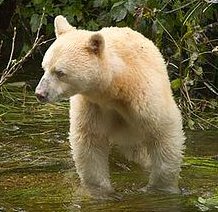Kermode Bear
Category: Bear

Facts about Kermode Bear, "Scientific name for Kermode Bear is Ursus americanus kermodei". Kermode Bear is the sub variety of the North American Black Bear that belongs to the genus Ursus of the Ursidae family. Kermode Bear is also commonly called as a Spirit Bear, chiefly in British Columbia. The Kermode Bear mostly live in the North and Central Coast areas of British Columbia in Canada. The Kermode Bear is renowned for about one-tenth of their population having cream or white-colored coats. This color morph is because of recessive genes, which is regular in the population. The Kermode bear was named after the earlier director of the Royal B.C. Museum, Francis Kermode, who researched the bear. The Kermode Bear is renowned as a prominent symbol of Native America and it is chosen as the authorized animal of British Columbia.
Features of Kermode Bear
Usually, a male Kermode Bear is much heavier than the female bears, which has a maximum body weight that ranges from 250 lbs to 300 lbs (113.6 kg to 136.4 kg), whereas the female Kermode Bear will have the body weight between 125 lbs and to 175 lbs (56.8 kg and 79.5 kg). The Kermode Bear will be capable of growing to a maximum height that ranges from 5 feet to 6 feet (150 cm to 180 cm).
Due to the special color and shortage of the Kermode Bear, this bear variety is respected by the local culture of Native America, which is referred to as the ghost bear. Consistent with legend of Native America, the Kermode Bear are a reminder of the past, particularly the white color of snow and ice, which also symbolizes harmony and peace.
The Kermode Bear holds an important place in the oral stories of the native people of the area. The bear has also been featured in a documentary film of the National Geographic channel. However, the Kermode Bear are not as successful at catching fish as other bears because they are less visible from the view of the fish. Contrary to the fashionable belief, the Kermode Bear are not albino. Their eyes, nose, paw and lips, are dark colored and the Kermode Bear are not associated with polar bears and other bears in any way. However, a black colored Kermode female bear can have a white cub occasionally. The home of the Kermode Bear includes thick forests with an abundance of streams, plants, animals and fish.
Diet of Kermode Bear
In the wild, the Kermode Bear feeds on all kinds of plants, bulbs, fruits, rodents, insects, salmon and nuts. Due to their plentiful food supply, it is simple for them to build up for the insensitive winters.
Breeding of Kermode Bear
Kermode bears usually mate during the summer season. When fall comes, the female Kermode Bear will find an appropriate place, such as a rock shelter, hollow tree trunk, or hillside dugout to build the den. They line up their dens with dried leaves, grass, and twigs for insulation and comfort. At the time of hibernation the Kermode Bear have a quasi sleep like condition to preserve energy during the chilly winter. Functions of their body will slow down and the bear will use the stored fat that has been accumulated all through the year. The female Kermode Bear will give birth to young ones in their den during hibernation, which continues until spring or the early part of the summer season, according to weather conditions. The female Kermode Bear is capable of giving birth to 1 to 3 cubs per litter and each cub will weigh about 1 lb (454 grams).
The average lifespan of the Kermode Bear is 20 years to 25 years in the wild, whereas in the captive, they can live more than 35 years.

 Back To Category Bear
Back To Category Bear